A Study on the Conceptual Design of a 50-Seat Supersonic Transport
Abstract
1. Introduction
2. Design Requirements of the 50-Seat SST
3. Layout of the Cabin
4. Initial Sizing
5. Refinement of the Initial Design
6. Optimum Wing Sizing
- Takeoff field length ≦ 6000 ft;
- Landing field length ≦ 6000 ft;
- Range ≧ 3500 NM;
- Gradient of second segment climb (SSC) ≧ 0.024.
7. Conclusions
- According to the weight estimation, the maximum takeoff weight may be largely reduced by advanced technology, such as using composite material for the structure.
- The final design was decided using a carpet plot with the minimum value of the maximum takeoff weight and satisfaction of design requirements.
- As a result of wing sizing, the constraint of climb gradient largely influenced the maximum takeoff weight. It is anticipated that flight performance at low speed will be enhanced by the use of high-lift devices.
- The laminar flow had a considerable impact on the improvement of aerodynamic efficiency during supersonic cruising.
Author Contributions
Funding
Data Availability Statement
Conflicts of Interest
Nomenclatures
| AR | aspect ratio |
| bypass ratio | |
| b | wing span |
| CD | drag coefficient |
| CD0 | parasite drag coefficient |
| CDi | induced drag coefficient |
| CDw | wave drag |
| CDL&P | drag due to leakage and protuberances |
| CDmisc | extra drag items due to flap, inlet spillage drag, cooling air drag, etc. |
| CDf | friction drag |
| Cf | mean friction coefficient |
| cj | specific fuel consumption [lb/hr/lb] |
| CL | lift coefficient |
| CLmaxTO | maximum lift coefficient at takeoff |
| CLmaxL | maximum lift coefficient at landing |
| d | fuselage diameter [m] |
| e | Oswald’s efficiency factor |
| h | maximum height of fuselage [m] |
| H | altitude [ft] |
| l | length [m] |
| L | fuselage length [m] |
| L/D | lift-to-drag ratio |
| Lp | lapse rate |
| M | Mach number |
| MAC | mean aerodynamic chord [m] |
| number of engines | |
| design ultimate load factor | |
| dynamic pressure [Pa] | |
| STOFL | takeoff field length [ft] |
| SFL | landing field length [ft] |
| S | wing area [m2] |
| T | engine thrust [lbf] |
| TTO,max | maximum thrust at takeoff |
| t/c | thickness ratio |
| T/W | thrust-to-weight ratio |
| V | flight speed [knot] |
| VA | approach speed [knot] |
| W | weight [lbf] |
| W1~W9 | end weight of each flight phase |
| WTO | maximum takeoff weight [lbf] |
| WE | empty weight [lbf] |
| WF | fuel weight [lbf] |
| WOE | operating empty weight [lbf] |
| WOP | weight of operation items |
| W/S | wing loading [lbf/ft2] |
| Wcrew | total weight of crew |
| γ | climb rate |
| η | efficiency factor |
| λ | taper ratio |
| Λ | sweep angle [deg] |
| ρ | air density [kg/m3] |
References
- CONCORDE SST—The Definitive Concorde Aircraft Site on the Internet. Available online: https://www.concordesst.com/ (accessed on 20 March 2025).
- Boom Technology Inc. Available online: https://boomsupersonic.com/ (accessed on 20 March 2025).
- Imagining a New Future for Supersonic Aviation—Exosonic. Available online: https://exosonic.com/ (accessed on 20 March 2025).
- Spike Aerospace Inc. Available online: https://www.spikeaerospace.com/ (accessed on 20 March 2025).
- SuperSonic Jet Planning Inc. Available online: https://www.superjet.jp/ (accessed on 20 March 2025).
- Commercial Supersonic Technology: The Way Ahead. 2001. Available online: https://nap.nationalacademies.org/read/10283/chapter/3 (accessed on 20 March 2025).
- Quesst: The Mission (nasa.gov). Available online: https://www.nasa.gov/quesst-the-mission/ (accessed on 20 March 2025).
- Shields, E.W.; Fenbert, J.W.; Ozoroski, L.P.; Geiselhart, K.A. Concept Development of a Mach 1.6 High Speed Civil Transport, NASA/TP-1999-209697. 1999. Available online: https://ntrs.nasa.gov/api/citations/20000032524/downloads/20000032524.pdf (accessed on 05 May 2025).
- Sakata, K. Supersonic experimental airplane (NEXST) for next generation SST, technology—Development and flight test plan for the unmanned scaled supersonic glider, AIAA-2002-0527. In Proceedings of the 39th Aerospace Sciences Meeting & Exhibit, Reno, NV, USA, 8–11 January 2002. [Google Scholar]
- Yoshida, K. Supersonic drag reduction technology in the scaled supersonic experimental airplane project by JAXA. Prog. Aerosp. Sci. 2009, 45, 124–146. [Google Scholar] [CrossRef]
- Makino, Y. Sky Frontier Program Silent supersonic transport technologies, Japan Aeronautical Engineers’ Association. Aviat. Eng. 2018, 765, 36–50. (In Japanese) [Google Scholar]
- Torenbeek, E.; Jesse, E.; Laban, M. Conceptual Design and Analysis of a Mach 1.6 Airliner. In Proceedings of the 10th AIAA/ISSMO Multidisciplinary Analysis and Optimization Conference, Albany, NY, USA, 30 August–1 September 2004; p. AIAA 2004-4541. [Google Scholar]
- Welge1, H.R.; Nelson, C.; Bonet, J. Supersonic Vehicle Systems for the 2020 to 2035 Timeframe, AIAA 2010-4930. In Proceedings of the 28th AIAA Applied Aerodynamics Conference, Chicago, IL, USA, 28 June–1 July 2010. [Google Scholar]
- Munoz, C.V.; Bonavolontà, G.; Lawson, C.; Riaz, A. Conceptual Design of a Next Generation Supersonic Airliner for Low Noise and Emissions, AIAA 2023-0215. In Proceedings of the AIAA SciTech Forum 2023, National Harbor, MD, USA, 23–27 January 2023. [Google Scholar]
- Kawanabe, T.; Lei, Z. A Study on the Conceptual Design of a Supersonic Business Jet. In Proceedings of the 59th Aircraft Symposium, Virtual, 22–24 November 2021. (In Japanese). [Google Scholar]
- Lei, Z. Potential of the Range Extension of Supersonic Transport, ICAS2024-0566. In Proceedings of the 34rd Congress of the International Council of the Aeronautical Sciences (ICAS), Florence, Italy, 9–13 September 2024. [Google Scholar]
- Ueno, A.; Watanabe, Y.; Salah El Din, I.; Grenon, R.; Carrier, G. Low Boom/Low Drag Small Size Supersonic Aircraft Design. In Proceedings of the VII European Congress on Computational Methods in Applied Sciences and Engineering, Crete, Greece, 5–10 June 2016. [Google Scholar]
- Berton, J.J.; Huff, D.L.; Seidel, J.A. Supersonic Technology Concept Aeroplanes for Environmental Studies, AIAA 2020-0263. In Proceedings of the AIAA SciTech Forum and Exposition, Orlando, FL, USA, 6–10 January 2020. [Google Scholar]
- Sun, Y.; Smith, H.; Chen, H. Conceptual Design of Low-Boom Low-Drag Supersonic Transports, AIAA 2020-2635. In Proceedings of the AIAA AVIATION 2020 Forum, Virtual Event, 15–19 June 2020. [Google Scholar]
- Carrier, G.G.; Cadillon, J.; Morel, F.; Grenson, P.; Atinault, O. Combined Conceptual and Preliminary Aerodynamic Design of a Low-Boom Supersonic Civil Transport Aircraft for Holistic Evaluation of Its Environmental Impact, AIAA 2021-2568. In Proceedings of the AIAA AVIATION 2021 Forum, Virtual Event, 2–6 August 2021. [Google Scholar]
- Liebhardt, B.; Linke, F.; Knaack, M. Supersonic Overland Without a Sonic Boom—Quantifying the Speed Advantage of Mach-Cutoff Flight, AIAA 2021-3188. In Proceedings of the AIAA AVIATION 2021 FORUM, Virtual Event, 2–6 August 2021. [Google Scholar]
- Timothy, M.S.; JimGhifari, A. FazaKoji Shimoyama, A multiobjective surrogate-assisted optimisation and exploration of low-boom supersonic transport planforms. Aerosp. Sci. Technol. 2022, 128, 107747. [Google Scholar]
- Jenkinson, L.R. Civil Jet Aircraft Design; American Institute of Aeronautics and Astronautics, Inc.: Washington, DC, USA, 1999. [Google Scholar]
- Raymer, D.P. Aircraft Design: A Conceptual Approach, 5th ed.; AIAA Educational Series; AIAA: Reston, VA, USA, 2012. [Google Scholar]
- Roskam, J. Airplane Design Part I: Preliminary Sizing of Airplanes; DARcorporation: Lawrence, KS, USA, 2005. [Google Scholar]
- Roskam, J. Airplane Design Part V: Component Weight Estimation; DARcorporation: Lawrence, KS, USA, 2003. [Google Scholar]
- Horinouchi, S. Concept Design of a Low Boom SSBJ to Satisfy Social Acceptance, ICAS2022-0762. In Proceedings of the 33rd Congress of the International Council of the Aeronautical Sciences, Stockholm, Sweden, 4–9 September 2022. [Google Scholar]
- Howe, D. Aircraft Conceptual Design Synthesis; Professional Engineering Publishing: London, UK, 2000. [Google Scholar]
- List of Commercial Jet Airliners, Wikipedia. Available online: https://en.wikipedia.org/wiki/List_of_commercial_jet_airliners (accessed on 20 March 2025).


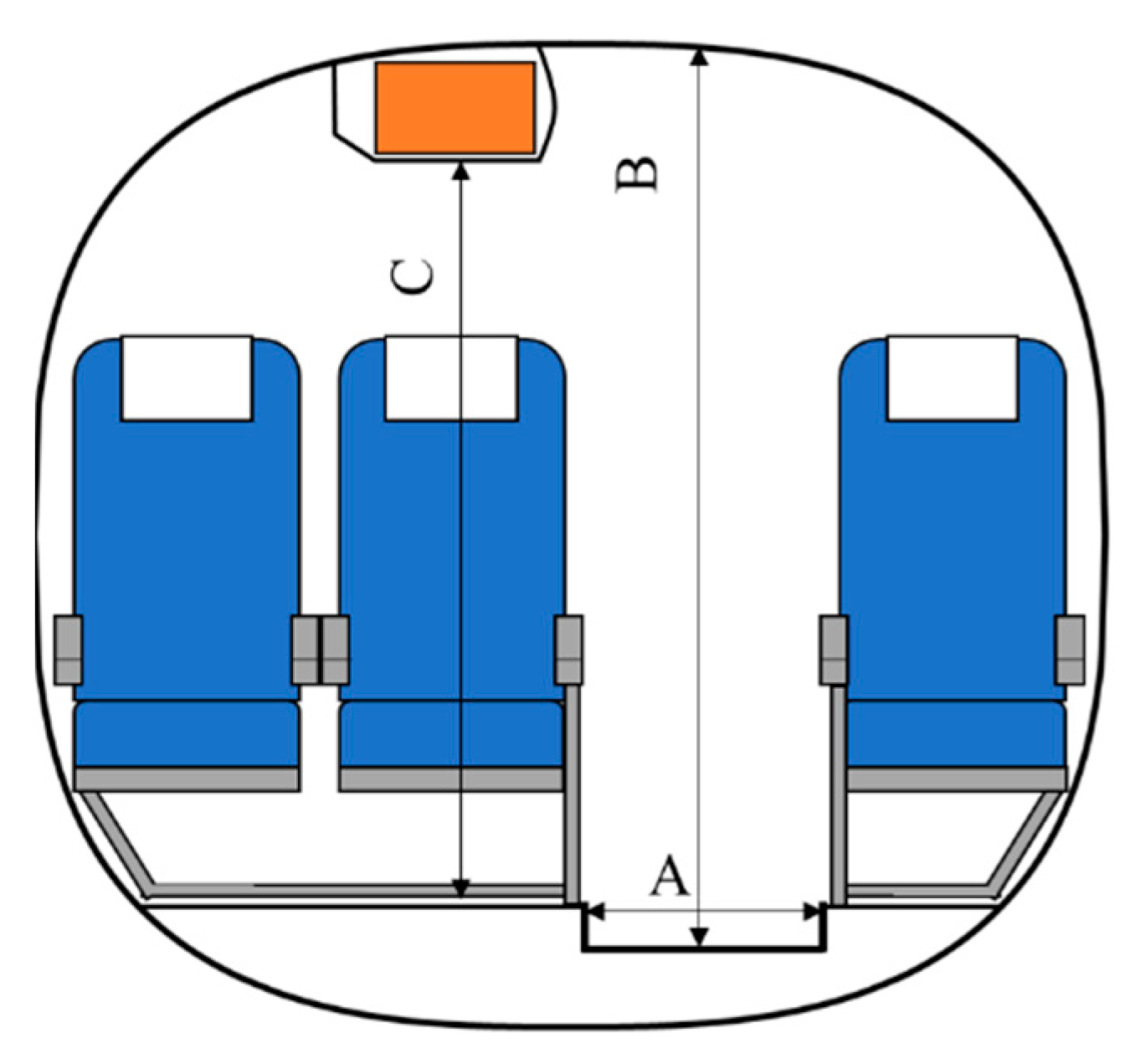
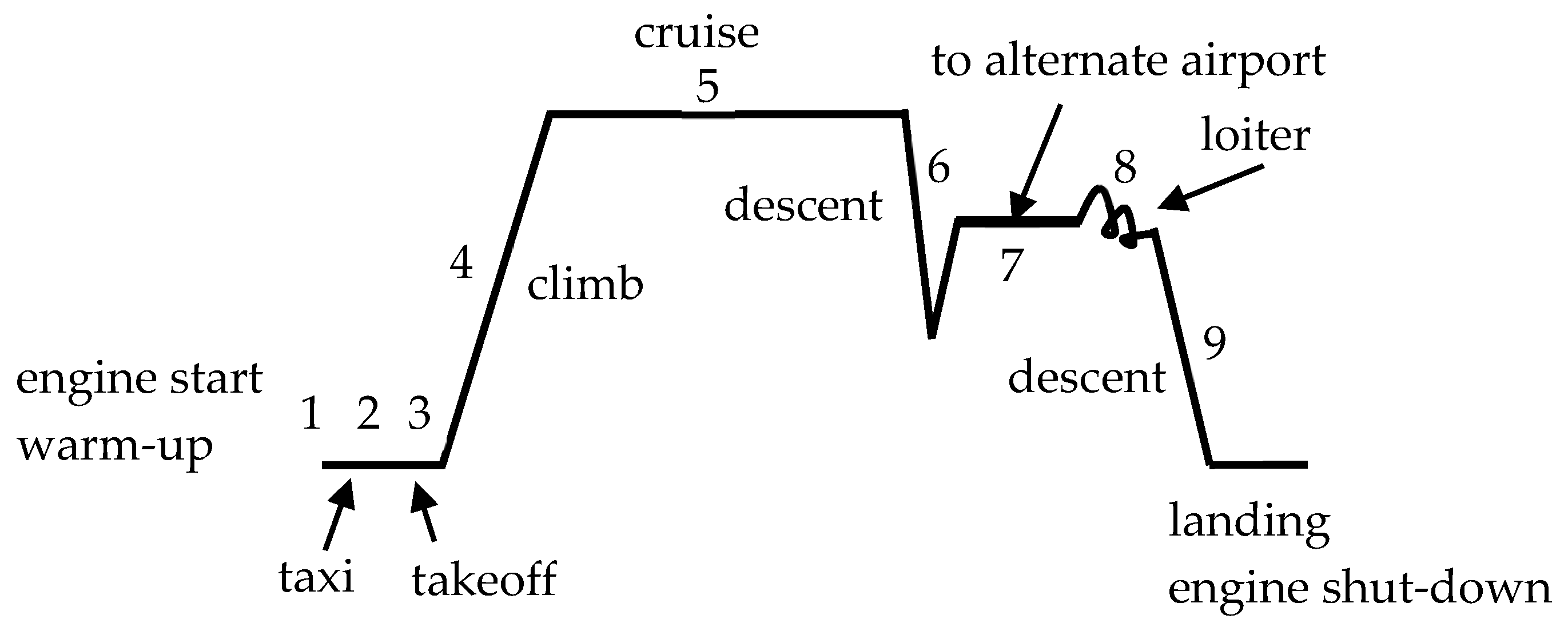
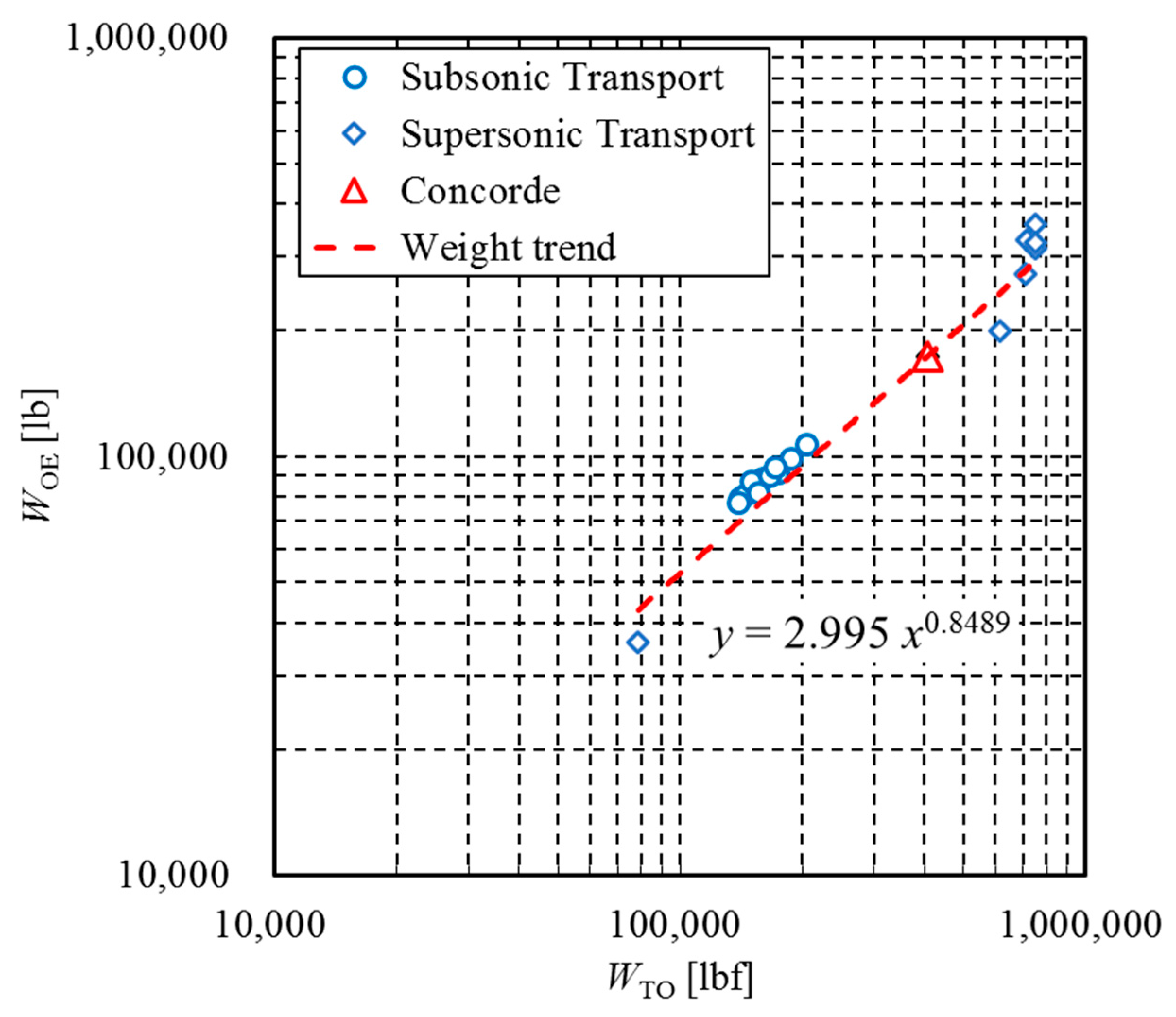
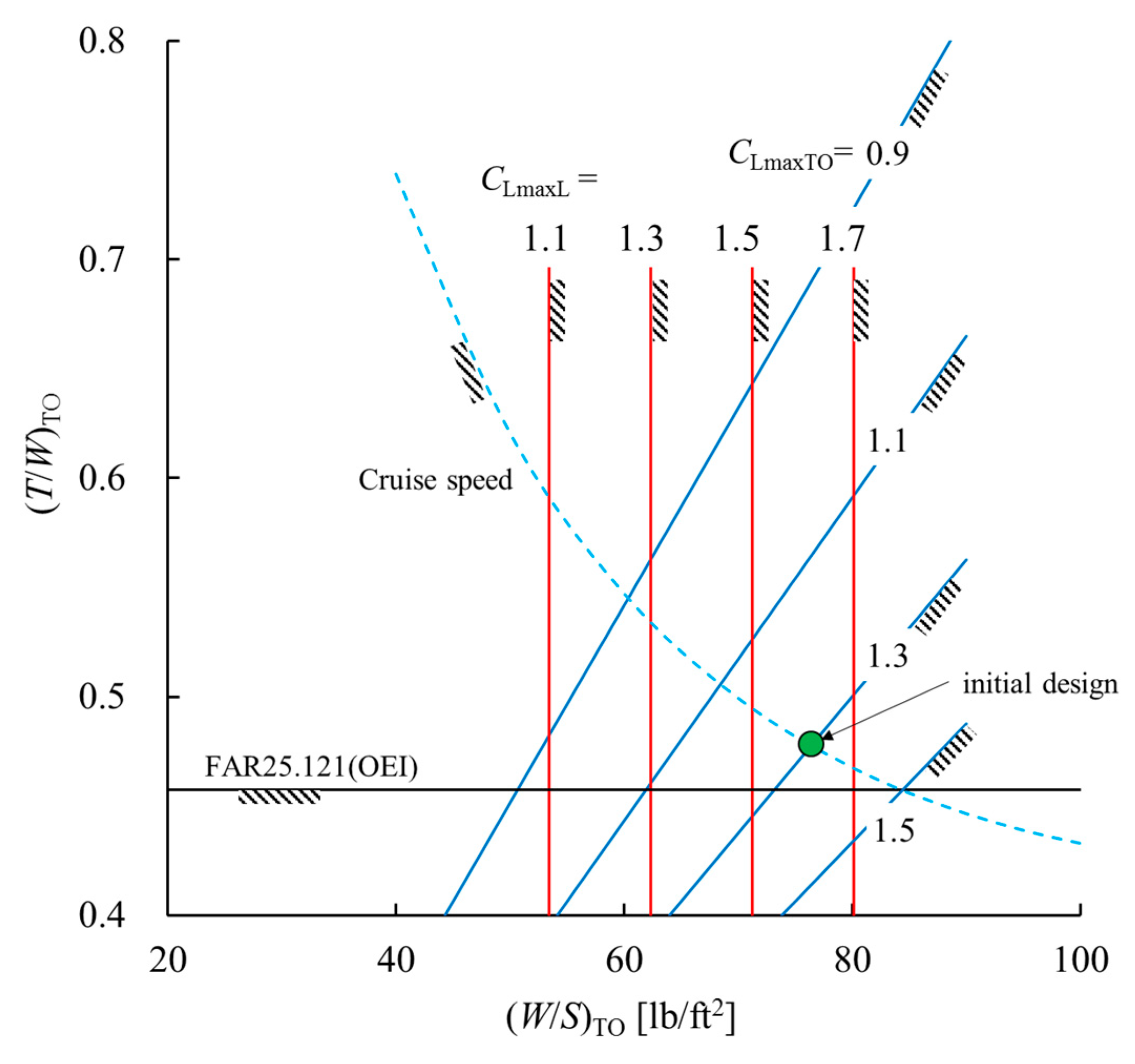

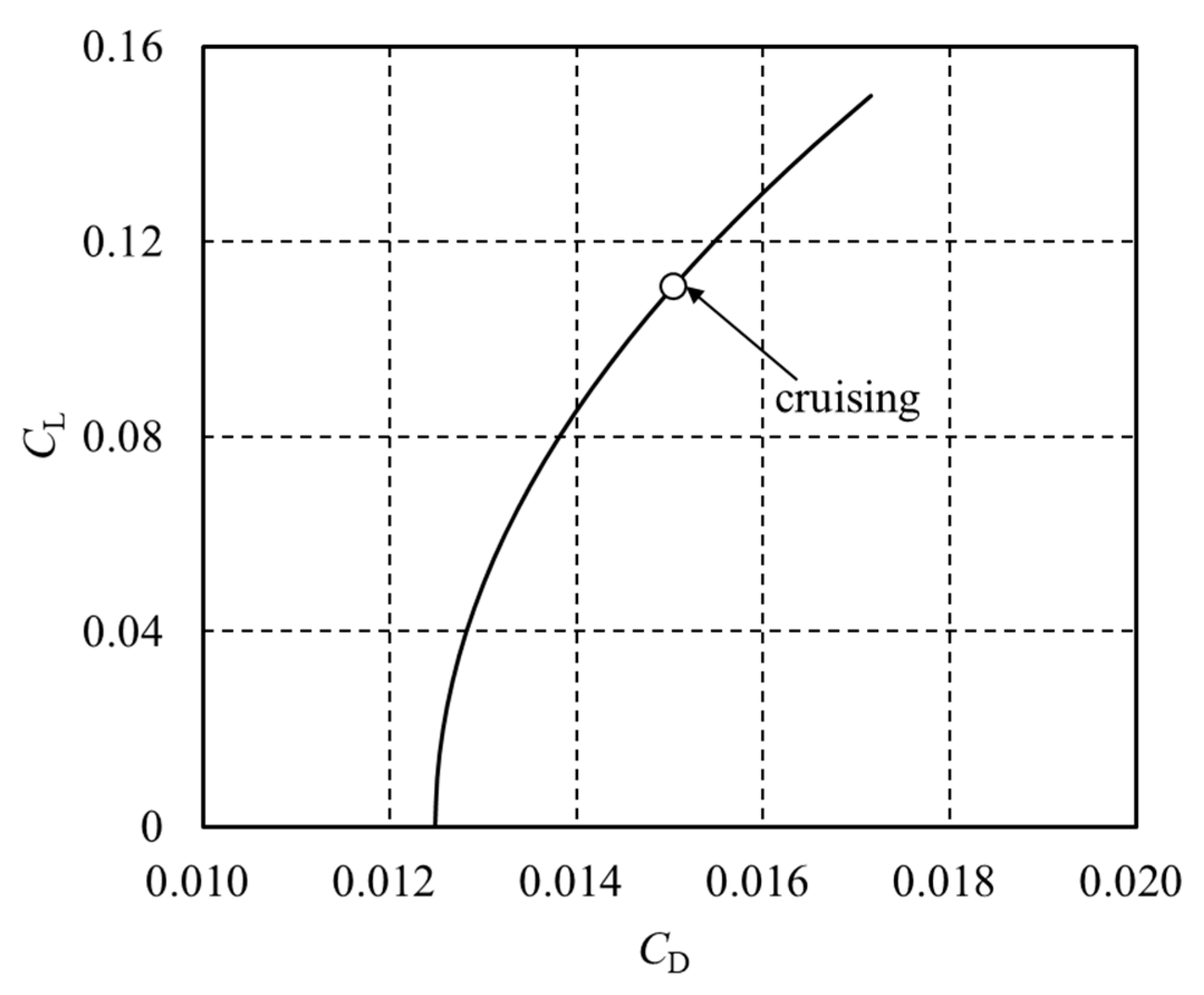
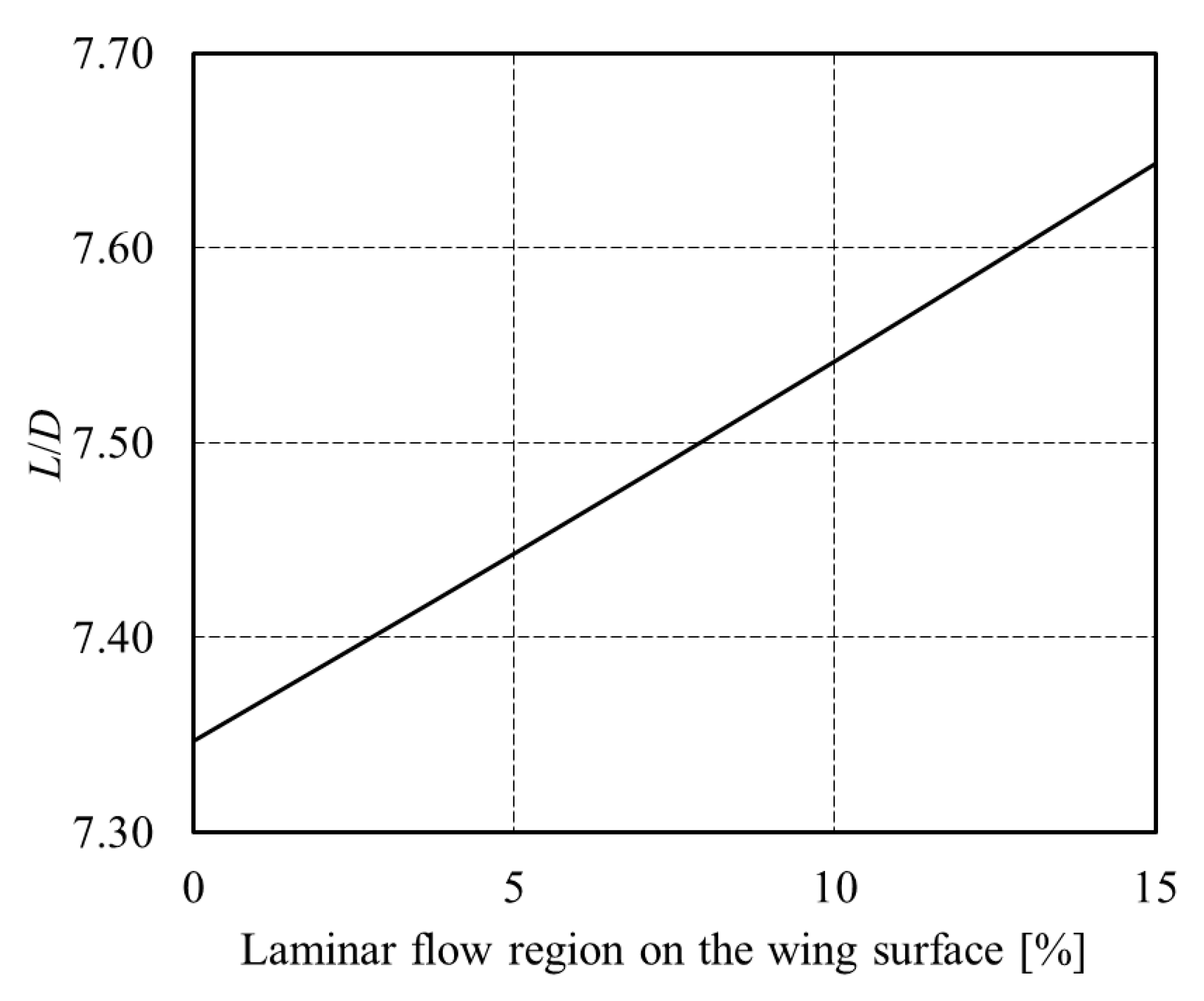
| Pilot + Crew | 2 + 2 |
| Seat | 50 |
| Range [NM] | 3500 |
| Altitude [ft] | 50,000 |
| Cruise Mach | 1.6 |
| [ft] | <6000 |
| [ft] | <6000 |
| backrest height | 0.80 | m |
| seat surface height | 0.45 | m |
| seat height | 1.25 | m |
| seat width | 0.63 | m |
| backrest width | 0.50 | m |
| pitch | 0.97 | m |
| cabin width | 2.40 | m |
| cabin height | 2.20 | m |
| aisle width (A in Figure 3) | 0.52 | m |
| aisle height (B in Figure 3) | 2.03 | m |
| overhead locker to floor (C in Figure 3) | 1.64 | m |
| Fuselage diameter | 2.60 | m |
| Nose length | 21.0 | m |
| Tail length | 24.0 | m |
| Cabin length | 20.0 | m |
| Fuselage length | 65.0 | m |
| Thickness of structural framework | 0.10 | m |
| Phase | Flight Status | Weight Ratio | Fraction |
|---|---|---|---|
| 1 | Engine start and warm-up | / | 0.990 |
| 2 | Taxi | / | 0.995 |
| 3 | Takeoff | / | 0.995 |
| 4 | Climb | / | 0.980 |
| 5 | Cruise | / | 0.630 |
| 6 | Descent | / | 0.985 |
| 7 | Alternate airport | / | 0.959 |
| 8 | Loiter | / | 0.968 |
| 9 | Landing and engine shut down | / | 0.992 |
| MTOW | 171,176 | lbf | |
| Fuel weight | 77,228 | lbf | |
| OEW | 82,998 | lbf |
| Wing loading [lbf/ft2] | 76.5 | |
| Thrust-to-weight ratio | 0.474 | |
| Wing area [ft2] | 2238 | |
| Maximum takeoff thrust [lbf] | 81,172 | |
| Lift coefficient at takeoff and landing | 1.3 | |
| 1.6 |
| 73,101 | 820 | 2048 | 825 | 76,794 | 10,950 | 77,227 | 164,971 |
| [lbf/ft2] | ||||
|---|---|---|---|---|
| 59.0 | 73.7 | 88.5 | ||
| 2.86 | ① | ② | ③ | |
| 3.57 | ④ | ⑤ | ⑥ | |
| 4.28 | ⑦ | ⑧ | ⑨ | |
[-] | [lbf/ft2] | [m] | [lbf] | [lbf] | [lbf] | [lbf] | [m] |
|---|---|---|---|---|---|---|---|
| 2.95 | 62.7 | 65 | 161,953 | 73,677 | 79,326 | 80,847 | 41.0 |
[-] | [m] | [m2] | [m] | [deg] | [deg] | [-] | |
|---|---|---|---|---|---|---|---|
| Wing | 2.95 | 26.6 | 240.1 | 10.95 | 77 | 55 | 0.11 |
| Horizontal tail | 2.5 | 13.61 | 74.1 | 5.90 | 55 | 55 | 0.332 |
| Vertical tail | 1.5 | 7.64 | 38.9 | 5.60 | 55 | 55 | 0.294 |
| Weight [lbf] | Altitude [ft] | Velocity [knot] | Mach Number [-] | |
|---|---|---|---|---|
| cruising | 124,323 | 50,000 | 918 | 1.6 |
| takeoff at | 161,953 | 0 | 131 | 0.199 |
| SSC at OEI | 161,953 | 0 | 131 | 0.199 |
| landing at | 161,953 | 0 | 118 | 0.179 |
| 0.0090 | 0.0024 | 0.0004 | 0.0006 | 0.0125 | 0.0025 | 0.0150 | 0.1103 | 7.347 |
[NM] | [ft] | [ft] | [-] |
|---|---|---|---|
| 3500 | 4709 | 5670 | 0.024 |
Disclaimer/Publisher’s Note: The statements, opinions and data contained in all publications are solely those of the individual author(s) and contributor(s) and not of MDPI and/or the editor(s). MDPI and/or the editor(s) disclaim responsibility for any injury to people or property resulting from any ideas, methods, instructions or products referred to in the content. |
© 2025 by the authors. Licensee MDPI, Basel, Switzerland. This article is an open access article distributed under the terms and conditions of the Creative Commons Attribution (CC BY) license (https://creativecommons.org/licenses/by/4.0/).
Share and Cite
Kawanabe, T.; Lei, Z. A Study on the Conceptual Design of a 50-Seat Supersonic Transport. Aerospace 2025, 12, 625. https://doi.org/10.3390/aerospace12070625
Kawanabe T, Lei Z. A Study on the Conceptual Design of a 50-Seat Supersonic Transport. Aerospace. 2025; 12(7):625. https://doi.org/10.3390/aerospace12070625
Chicago/Turabian StyleKawanabe, Taichi, and Zhong Lei. 2025. "A Study on the Conceptual Design of a 50-Seat Supersonic Transport" Aerospace 12, no. 7: 625. https://doi.org/10.3390/aerospace12070625
APA StyleKawanabe, T., & Lei, Z. (2025). A Study on the Conceptual Design of a 50-Seat Supersonic Transport. Aerospace, 12(7), 625. https://doi.org/10.3390/aerospace12070625






